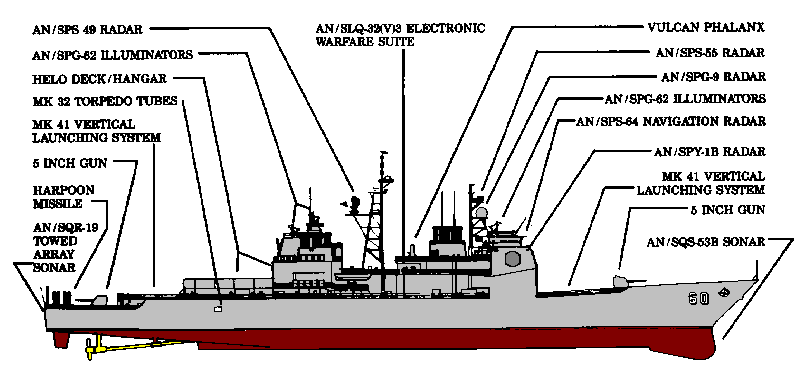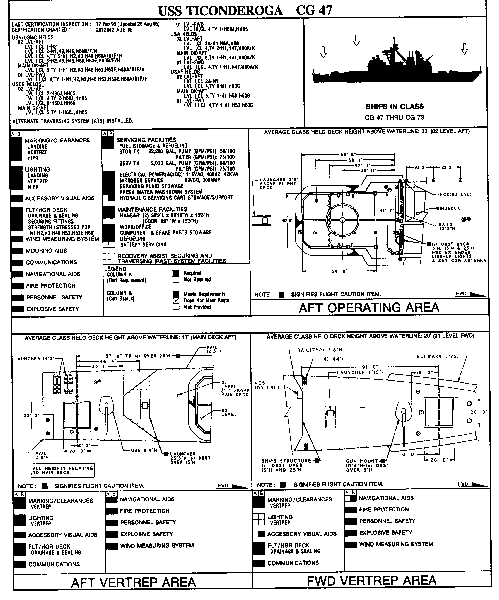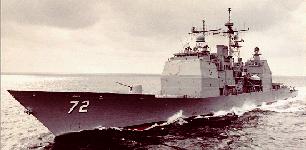



Modern US Navy guided missile cruisers perform primarily in a Battle Force role. Due to their extensive combat capability, these ships have been designated as Battle Force Capable (BFC) units. Their primary armament is the Vertical Launching System (VLS) employs both the long range surface-to-surface Tomahawk Cruise Missile and the Standard Surface-to-Air Missile. These multi-mission ships are capable of sustained combat operations in any combination of Anti-Air, Anti-Submarine, Anti- Surface, and Strike warfare environments. They are built to be employed in support of Carrier Battle Groups, Amphibious Assault Groups, as well as interdiction and escort missions.
The Ticonderoga class, using the highly successful Spruance hull, was initially designated as a Guided Missile Destroyer (DDG), but was redesignated as a Guided Missile Cruiser (CG) on January 1, 1980. The Ticonderoga class were the first surface combatant ships equipped with the AEGIS Weapons System, the most sophisticated air defense system in the world. Technological advances in the Standard Missile coupled with the AEGIS combat system in Ticonderoga class cruisers and the upgrading of older cruisers have increased the AAW capability of surface combatants. The heart of the AEGIS system is the SPY-1A radar, which automatically detects and tracks air contacts to beyond 200 miles. The AEGIS Weapons System is designed to defeat attacking missiles and provide quick reaction, high firepower, and jamming resistance to deal with the Anti-Air Warfare threat expected to be faced by the Battle Group.
Twenty-two TICONDEROGA-class AEGIS cruisers, starting with CG-52, have vertical launch systems (VLS) which permit them to carry and launch significant numbers of TOMAHAWK precision strike cruise missiles against targets of military importance deep in enemy territory. This land attack capability, coupled to their AEGIS anti-air missile systems, AN/SQQ-89 Undersea Warfare system and sophisticated C4ISR suite, make these ships the most powerful surface combatants in service with any navy. A new modernization plan for surface combatants would decommission some ships early, but would boost the firepower of the remaining force by adding the Vertical Launch System (VLS). The five TICONDEROGA-class cruisers in the fleet without VLS would receive the system: USS TICONDEROGA (CG 47), USS YORKTOWN (CG 48), USS VINCENNES (CG 49), USS VALLEY FORCE (CG 50) and USS THOMAS GATES (CG 51).The Ticonderoga class also brings a multi-warfare capability to the Fleet which significantly strengthens Battle Group operation effectiveness, defense, and survivability. The cruisers are equipped with Tomahawk ASM/LAM giving them additional long range strike mission capability. The addition of Tomahawk ASM/LAM in the CG-47 class has vastly complicated unit target planning for any potential enemy and returned an offensive strike role to the surface forces that seemed to have been lost to air power at Pearl Harbor. Two five-inch gun mounts are used against threatening ships and boats, low-flying aircraft, or to bombard shore targets. In addition, the ships carry a strong Anti-Submarine Warfare Suite and the Navy's latest Electronic Warfare Suite is also aboard. The cruisers have the most advanced underwater surveillance system available today. The Anti-Submarine Warfare (ASW) equipment consists of a hull-mounted SONAR, an Acoustic Array SONAR which is towed like a tail behind the ship, and a helicopter that can locate ships or submarines over 100 miles away.
The "Tico" cruisers, using the SPRUANCE Class hull, measure 567 feet from bow to stern. Their beam is 55 feet, and displacement is 9,600 tons. Four powerful gas turbine engines propel the ships to speeds greater than 30 knots, and two controllable-reversible pitch propellers assist in rapid acceleration and maneuverability.
Authorized in Fiscal Year 1978, TICONDEROGA's keel laying ceremony occurred on 27 January 1980. The first five Ticonderoga-class cruisers�Ticonderoga (CG-47) through Thomas S. Gates (CG-51)�have an early, less capable version of the Aegis combat system and do not have VLS or the capability to launch Tomahawk cruise missiles. Also, the first two ships of the class have two SH-2F helicopters instead of the SH-60B helicopter employed on later cruisers. The guided missile cruiser Port Royal (CG 73) was comissioned on Saturday, July 9, 1994. Port Royal was the last of 27 Ticonderoga class Aegis guided missile cruisers scheduled to be built. These new cruisers have replaced older, less capable ships that are being taken out of service as part of the Navy's overall plan to recapitalize the fleet.
These ships were built in sections, called modules, which allowed improved access to all areas of the ship during construction. The modules were then moved together to form the hull of the ship, and the deckhouse sections were then lifted aboard. For launching, the ship was moved several hundred yards across land to the floating dry dock, which was used to actually launch the ship.During their construction, hundreds of subassemblies were built and outfitted with piping sections, ventilation ducting, and other shipboard hardware. These subassemblies were then joined to form modules, which were then outfitted with larger equipment items, such as propulsion and power generation machinery and electrical panels. This represents an advancement from traditional shipbuilding in which these systems are installed in tight quarters below decks after the hull is completed. At Ingalls, four of these pre-outfitted hull and superstructure modules are joined together to form the ship shortly before it is moved to the water's edge and launched.
At the shipyards, this modular process is supported by an extensive Computer- Aided Design (CAD)/Computer-Aided Manufacturing (CAM) program that has significantly enhanced the efficiency of detail design, and has reduced the number of manual steps involved in converting design drawings to ship components. The three-dimensional CAD system is linked with an integrated CAM production network of computers throughout the shipyard. The CAD system directs the operation of numerically-controlled manufacturing equipment used to cut steel plates, cut and bend pipe, and form sheet metal assemblies.
Launching involved movement over land via a wheel- on-rail transfer system onto the shipyard launch and recovery dry dock, which is was ballasted down in order for the ship to float free and moved to an outfitting berth in preparation for the traditional christening ceremony. Upon completion of post-launch outfitting, the cruisers went through an extensive dockside and at-sea testing period to ensure the ship and crew were ready to safely go to sea.
The Smart Ship Project was initiated by an October 1995 brief from the Naval Research Advisory Committee (NRAC) panel on reduced manning to the Chief of Naval Operations. Their report stated that the major obstacle to reduced crew size and decreased life cycle costs aboard Navy ships was culture and tradition rather than the lack of proven technology and know-how. The challenge was to demonstrate in an operational ship that reductions in workload and crew requirements were possible while maintaining mission readiness and safety. The Commander, Naval Surface Force, US Atlantic Fleet (COMNAVSURFLANT) was designated as Executive Agent for the Smart Ship Project and nominated USS YORKTOWN (CG 48) as the ship in which to implement ideas to demonstrate the concept. SMART SHIP "CORE TECHNOLOGIES"All approved Smart Ship initiatives were implemented aboard YORKTOWN prior to her deployment in December 1996. Huge chunks of the ship were torn up and thrown away and replaced by computer consoles and miles of fiber optic cable.
In the Fall 1998 USS THOMAS S. GATES (CG 51) was scheduled as the first installation ship in the US Navy's Integrated Ship Controls (ISC) Program. This upgrade program will install innovative labor and cost savings initiatives on USS THOMAS S. GATES, USS TICONDEROGA (CG 47), USS VINCENNES (CG 49) and USS VALLEY FORGE (CG 50). Many of the technologies to be installed are the result of the initiatives proven sucessful on YORKTOWN. The upgrade program also includes options to install systems on the remaining 22 CG 47 Class AEGIS Cruisers. Modernization of the machinery control system for CG 47 Class ships is required in order to overcome impending obsolescence, reduce operating and support costs, and facilitate workload reductions. This will be accomplished with the installation of commercial off-the-shelf/non-developmental items (COTS/NDI).
The Aegis Cruiser force will remain on the front line into the 21st century, with upgrades as part of the Cruiser Conversion program. This conversion program will ensure the relevance of these ships in the future. Without this program, their future is tenuous. In the program, the modernized combat system will address the growing theater ballistic missile threat by incorporation of area and theater-wide TBMD capability. Additionally, introduction of two five inch 62 caliber guns with extended range guided munitions in 22 of these ships will help meet the USMC requirements for fire support. They will continue to receive upgrades to their command and control suites to ensure they remain full participants in the joint battlespace. This conversion program takes advantage of the sizable investment ($22B) already made in these ships, and keeping them ready to meet the challenge over 40 years of service life. It is important to note that the first five AEGIS cruisers (CG47 � CG51) are not part of the Cruiser Conversion program because of affordability.
Specifications | ||||
| Builders |
Ingalls Shipbuilding: CG-47-50, CG 52-57, 59,62, 65-66, 68-69, 71-73 Bath Iron Works: CG-51,58,60-61,63-64,67,70 | |||
| Propulsion |
4 General Electric LM-2500 Gas Turbine Engines (80,000
Shaft Horsepower) 2 Controllable-Reversible Pitch Propellers 2 Rudders | |||
| Length | Overall Length: 567 ft Waterline Length: 529 ft | |||
| Beam |
Extreme Beam: 55 ft Waterline Beam: 55 ft | |||
| Draft |
Maximum Navigational Draft: 33 ft Draft Limit: 23 ft | |||
| Displacement | Light Displacement: 7103 tons Full Displacement: 9957 tons Dead Weight: 2854 tons | |||
| Speed | 30 plus knots | |||
| Aircraft | Two SH-2 Seasprite (LAMPS) in CG 47-48 Two SH-60 Sea Hawk (LAMPS III) | |||
| Armament |
1 MK 7 MOD 3 AEGIS Weapons System
2 MK 32 MOD 14 Torpedo Tubes - 6 MK-46 torpedoes 2 MK 45 5"/54-Caliber Lightweight Gun Mounts 1 MK 15 MOD 2 Close-in-Weapons Systems (CIWS) (2 Mounts) 1 MK 36 MOD 2 Super Rapid-Blooming Off-Board Chaff System 2 50-Caliber Machine Guns | |||
| Combat Systems | ||||
| Crew | 24 Officers, 340 Enlisted | |||
| Unit Operating Cost Annual Average | $28,000,000 [source: [FY1996 VAMOSC] | |||
Ships | ||||||
| Name | Number | Builder | Homeport | Ordered | Commissioned | Decommissioned |
| Ticonderoga | CG 47 | Ingalls | Pascagoula | 22 Sep 1978 | 22 Jan 1983 | 2018 |
| Yorktown | CG 48 | Ingalls | Pascagoula | 28 Apr 1980 | 04 Jul 1984 | 2019 |
| Vincennes | CG 49 | Ingalls | San Diego | 28 Aug 1981 | 06 Jul 1985 | 2020 |
| Valley Forge | CG 50 | Ingalls | San Diego | 28 Aug 1981 | 18 Jan 1986 | 2021 |
| Thomas S. Gates | CG 51 | Bath | Norfolk | 20 May 1982 | 22 Aug 1987 | 2022 |
| Bunker Hill | CG 52 | Ingalls | Yokosuka | 15 Jan 1982 | 20 Sep 1986 | 2021 |
| Mobile Bay | CG 53 | Ingalls | Yokosuka | 15 Jan 1982 | 21 Feb 1987 | 2022 |
| Antietam | CG 54 | Ingalls | San Diego | 20 Jun 1983 | 06 Jun 1987 | 2022 |
| Leyte Gulf | CG 55 | Ingalls | Mayport | 20 Jun 1983 | 26 Sep 1987 | 2022 |
| San Jacinto | CG 56 | Ingalls | Norfolk | 20 Jun 1983 | 23 Jan 1988 | 2023 |
| Lake Champlain | CG 57 | Ingalls | San Diego | 16 Dec 1983 | 12 Aug 1988 | 2023 |
| Philippine Sea | CG 58 | Bath | Mayport | 27 Dec 1983 | 18 Mar 1989 | 2024 |
| Princeton | CG 59 | Ingalls | San Diego | 16 Dec 1983 | 11 Feb 1989 | 2024 |
| Normandy | CG 60 | Bath | Norfolk | 26 Nov 1984 | 09 Dec 1989 | 2024 |
| Monterey | CG 61 | Bath | Norfolk | 26 Nov 1984 | 16 Jun 1990 | 2025 |
| Chancellorsville | CG 62 | Ingalls | Yokosuka | 26 Nov 1984 | 04 Nov 1989 | 2024 |
| Cowpens | CG 63 | Bath | San Diego | 08 Jan 1986 | 09 Mar 1991 | 2026 |
| Gettysburg | CG 64 | Bath | Mayport | 08 Jan 1986 | 22 Jun 1991 | 2026 |
| Chosin | CG 65 | Ingalls | Pearl Harbor | 08 Jan 1986 | 12 Jan 1991 | 2026 |
| Hue City | CG 66 | Ingalls | Mayport | 16 Apr 1987 | 14 Sep 1991 | 2026 |
| Shiloh | CG 67 | Bath | San Diego | 16 Apr 1987 | 18 Jul 1992 | 2027 |
| Anzio | CG 68 | Ingalls | Norfolk | 16 Apr 1987 | 02 May 1992 | 2027 |
| Vicksburg | CG 69 | Ingalls | Mayport | 25 Feb 1988 | 14 Nov 1992 | 2027 |
| Lake Erie | CG 70 | Bath | Pearl Harbor | 25 Feb 1988 | 24 Jul 1993 | 2028 |
| Cape St. George | CG 71 | Ingalls | Norfolk | 25 Feb 1988 | 12 Jun 1993 | 2028 |
| Vella Gulf | CG 72 | Ingalls | Norfolk | 25 Feb 1988 | 18 Sep 1993 | 2028 |
| Port Royal | CG 73 | Ingalls | Pearl Harbor | 25 Feb 1988 | 09 Jul 1994 | 2029 |



